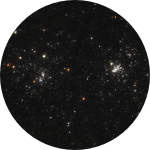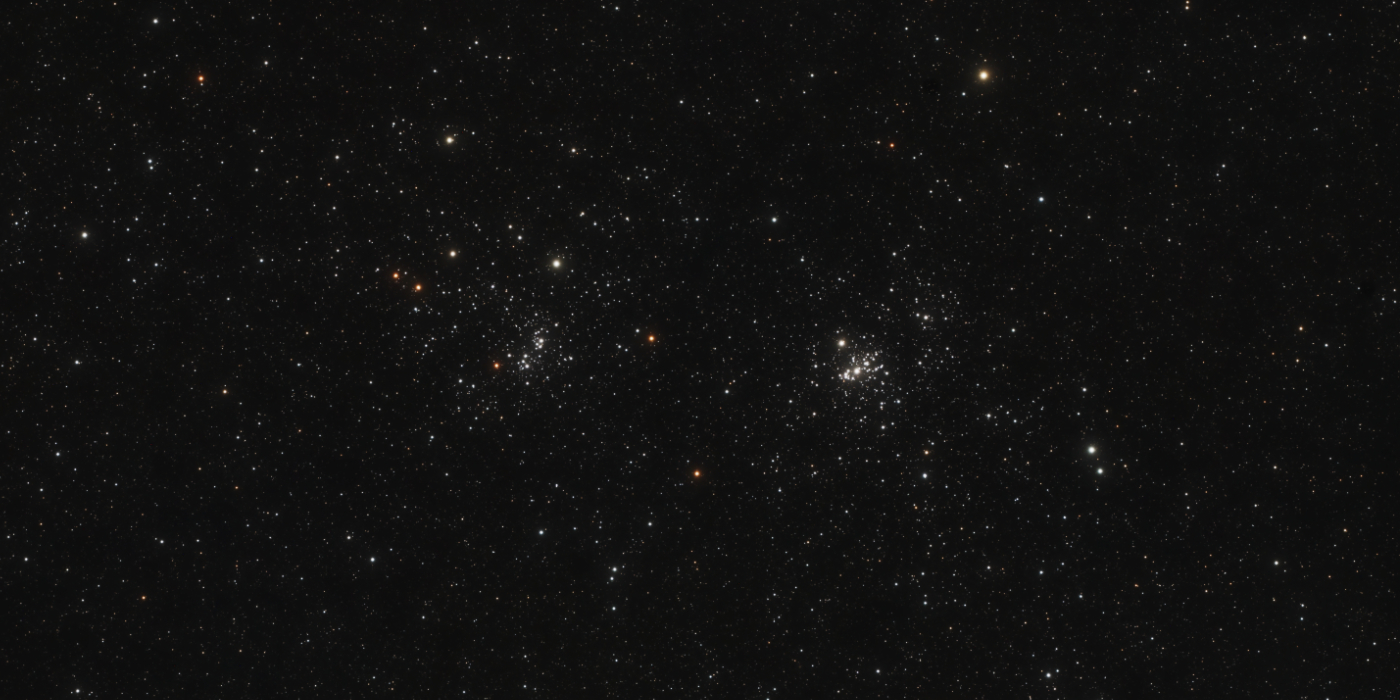 Double Cluster - a dazzling twin set of star clusters in Perseus Double Cluster - a dazzling twin set of star clusters in Perseus |  | Rising high in the autumn and winter skies of the Northern Hemisphere, the Double Cluster in Perseus is a stunning pair of open star clusters that offers one of the most visually rewarding views in the night sky. Officially cataloged as NGC 869 and NGC 884, these two dense clusters lie side by side, separated by only about half a degree — close enough to appear together in the same field of view with binoculars or a wide-field telescope.
The Double Cluster sparkles with hundreds of hot, young blue-white stars, many of them less than 15 million years old. Each cluster is impressive on its own, but when viewed together, they form a symmetric, jaw-dropping display that appears almost like a cosmic jewel box. With a low-power eyepiece, you’ll see a river of faint stars connecting them, and each cluster has its own character and arrangement of brighter stars.
They lie in the rich Milky Way region between Cassiopeia and Perseus, and are easily visible with the naked eye from dark skies as a faint, fuzzy patch. Through binoculars or a small scope, they explode into a shimmering star field — a perfect target for beginners, yet still a favorite of seasoned observers. No filters are needed — just a clear sky and a comfortable chair.
Whether you’re showing the night sky to friends or enjoying a solo observing session, the Double Cluster is a must-see — a timeless favorite for its beauty, accessibility, and starry abundance.
| | | Double Cluster | Target
Rating | 🟣 Showpiece Target | Star-Hop
Level | 🟣 Very Easy | Best
Viewing | September through February | The Double Cluster in Perseus (NGC 869 and NGC 884) is one of the most stunning and rewarding objects in the northern sky — a true visual treat for stargazers of all levels. Here are some great reasons to add the Double Cluster to your observing list:
⭐️ It’s a spectacular binocular and low-power telescope target
● Both clusters fit in a single field of view in binoculars or a wide-field eyepiece.
● It’s one of the few deep-sky objects that provides a true “wow” factor” even in modest equipment.
⭐️ It’s bright and easy to find
● At magnitude 4, the Double Cluster is visible to the naked eye as a faint smudge in a dark sky.
● It’s easy to locate by star-hopping from the familiar W-shape of Cassiopeia.
● Ideal for quick observing sessions, public star parties, or just scanning the sky.
⭐️ It’s rich with stars and visual texture
● Each cluster contains hundreds of young, hot, blue-white stars, and the field is peppered with many faint background stars.
● Observers describe the view as sparkling, with arcs, lines, and star chains.
● A bright orange star sits between the two clusters — a striking color contrast against the sea of blues.
⭐️ It’s a meaningful astronomical pairing
● They are 7,500 light-years away and less than 100 light-years apart and likely formed from the same massive star-forming region.
● Observing them gives a sense of the scale and structure of our galaxy — a double open cluster drifting in the Perseus Arm of the Milky Way.
⭐️ It’s well-placed for fall and winter viewing
● Best seen from September through February in the Northern Hemisphere.
● Located high in the northeastern sky in fall evenings — ideal for long, comfortable sessions without neck strain.
|
| Finding: Double Cluster |  Find the constellation Cassiopeia. Look for the distinctive 'W' or 'M' shape in the northeaster sky in the fall, or overhead in winter. The two end stars in the "W" are Ruchbah and Segin -- these will help guide you in the next step.
Find the constellation Cassiopeia. Look for the distinctive 'W' or 'M' shape in the northeaster sky in the fall, or overhead in winter. The two end stars in the "W" are Ruchbah and Segin -- these will help guide you in the next step.
 Draw a triangle from Segin and Ruchbah downward toward Perseus about 7° on a side -- a bit less than the width of your fist. Look for the glow of the Double Cluster -- it should be visible in Bortle 1-4 skies. If you don't see it, simply estimate the location.
Draw a triangle from Segin and Ruchbah downward toward Perseus about 7° on a side -- a bit less than the width of your fist. Look for the glow of the Double Cluster -- it should be visible in Bortle 1-4 skies. If you don't see it, simply estimate the location.
 Using a binocular or telescope finder, point to the location of the Double Cluster. If you are using a telescope, scan the area with a low-powered eyepiece until you find the Double Cluster. Then explore.
Using a binocular or telescope finder, point to the location of the Double Cluster. If you are using a telescope, scan the area with a low-powered eyepiece until you find the Double Cluster. Then explore.
|
| Viewing: Double Cluster |  | Viewing Tips
The Double Cluster in Perseus (NGC 869 & NGC 884) is one of the most visually stunning and beginner-friendly objects in the night sky. Whether you’re using binoculars or a telescope, here are some top tips to help you enjoy it to the fullest:
⭐️ Use binoculars or a wide-field telescope
● This is one of the best binocular targets in the sky — 7x50 or 10x50 binoculars show both clusters in the same field, sparkling with dozens of stars.
● In a telescope, use low magnification (25x–50x) and a wide field of view (1° or more) to fit both clusters in the same eyepiece.
● The view is especially magical when you can see them side by side, like twin islands of stars.
⭐️ No filters needed — just clear skies
● The Double Cluster shines best without filters, since it consists of bright stars, not nebulosity.
● Observing under dark, transparent skies brings out more stars and depth, but it’s still beautiful even from suburban areas.
⭐️ Let your eyes adapt — and linger
● Spend a few minutes observing — the longer you look, the more stars will reveal themselves.
● Averted vision (looking slightly to the side) can help pick up the fainter stars.
● Look for subtle patterns, curved chains, and orange-red stars that provide striking contrast against the bluer stars.
⭐️ Sit back and enjoy it
● This is a perfect object for relaxed observing — bring a reclining chair or sit at the eyepiece with a low-power setup.
● It’s a great “end of night” target to wind down with, or a first light object to show off the beauty of the sky.
|  | ✅ Naked Eye
● Visibility: Visible under dark skies (Bortle 1–4)
● Appears as a faint, fuzzy patch of light nestled between Cassiopeia and Perseus.
● Best seen when sky is dark and transparent.
● Looks like a single unresolved glow, but still stands out from surrounding stars.
|  | ✅ Binoculars (7x50, 10x50, 15x70)
● Visibility: Stunning binocular target
● Each cluster appears as a tight group of stars, with dozens of bright, blue-white points resolved.
● Both clusters comfortably fit in the same field of view — one of the few deep-sky objects with this benefit.
● You’ll notice a few orange-tinted stars and curved star chains, which add visual texture.
|  | ✅ Small Telescope (<4")
● Visibility: Rich and beautiful star fields
● More faint stars appear, and you’ll begin to notice subtle differences in the structure of each cluster.
● A wide-field eyepiece helps you keep both clusters in view together — a major aesthetic bonus.
|  | ✅ Medium Telescope (4-8")
● Visibility: Dazzling, immersive star fields
● The clusters fill the view with dozens to hundreds of resolved stars.
● You’ll see delicate arcs, bright anchor stars, and 3D layering.
● Zoom in to explore one at a time.
● Especially good under Bortle 1–3 skies, where the surrounding field is richly filled with background stars.
|  | ✅ Large Telescope (10"+)
● Visibility: Exceptional resolution, detail, and contrast
● The clusters are densely packed with bright stars, and fainter stars become visible throughout the field.
|
| Sky Darkness Level | Viewing Quality |
| The Double Cluster in Perseus (NGC 869 & NGC 884) is a bright and resilient deep-sky object, making it visible across a wide range of Bortle classes — from pristine rural skies to moderately light-polluted suburbs. However, its beauty and richness vary with sky darkness. |
| Bortle 1 (Pristine Dark Sky) |
✅ Outstanding view. Naked eye: Clearly visible as a double glow. Binoculars and telescopes reveal a sparkling sea of stars, including faint background stars and subtle color contrasts (especially orange and blue stars). The clusters show a rich, 3D-like depth, with delicate arcs and star chains. A truly mesmerizing sight — one of the best open cluster views in the sky.
|
| Bortle 2 (Very Dark Sky) |
✅ Excellent. Naked eye: Still visible as a soft fuzzy patch. Binoculars show both clusters with great contrast and clarity. Telescopes of any size reveal hundreds of stars, with structure and fine detail still standing out beautifully.
|
| Bortle 3 (Rural) |
✅ Very good visibility. Naked eye: Still detectable as a glow. The clusters remain bright and well-defined in binoculars and telescopes. Star fields are slightly less deep, but the overall view is still impressive, and individual stars remain sharp. |
| Bortle 4 (Rural/Suburban Edge) |
✅ Good, with some skyglow. Naked eye: May not be noticed unless specifically looking for it. Binoculars show the clusters well, though background stars start to fade. In telescopes, the core stars are still brilliant, but fine contrast begins to diminish. Still a satisfying and worthwhile target.
|
| Bortle 5 (Suburban) |
⚠️ Visible, but washed out. Naked eye: Likely invisible. Binoculars and small scopes show the core stars clearly, but fainter members are lost in skyglow. Still recognizable as two clusters, but the “sparkle” and richness are muted.
|
| Bortle 6-7 (Bright Suburbs to City Edge) |
⚠️ Cluster cores visible, but depth is lost. Naked eye: Not visible. Through scopes, the clusters appear as tight knots of stars with minimal surrounding star field. Color contrast is difficult to detect, and the surrounding Milky Way is not visible. Still makes a decent target for public viewing, but not its best showing.
|
| Bortle 8-9 (Urban/Inner city) |
❗ Difficult and dull. Naked eye: Invisible. Only the brightest stars of each cluster are visible in small scopes. Appears more like a sparse patch of stars, with no contrast or richness. Larger scopes with wide-field eyepieces help, but the full impact is greatly reduced.
|
| | ▶︎ Constellations of Fall
▶︎ Perseus
▶︎ Double Cluster |
|
|



